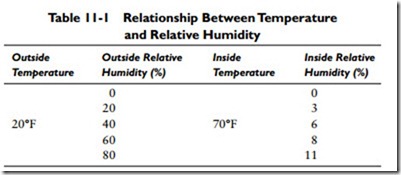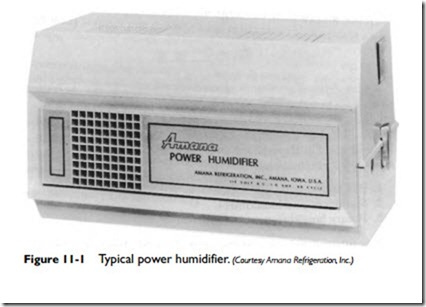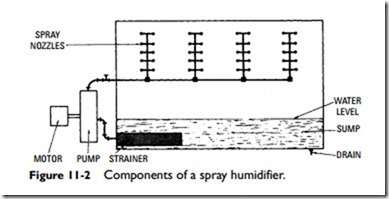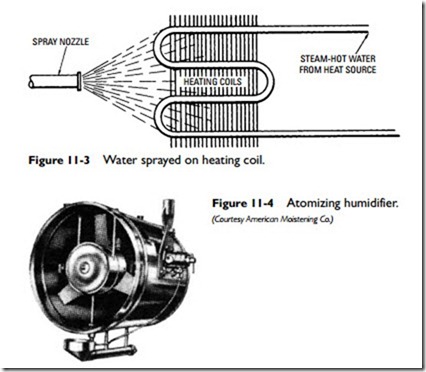The air around us has a capacity for holding a specific amount of water at given temperatures. For example, 10,000 ft3 of air at 70°F will hold 10.95 pints of water, no more. This means the air in a home 25 ft by 50 ft with 8-ft ceilings (10,000 ft3) could hold nearly 11 pints of water when the temperature inside is 70°F. This would represent 100 percent relative humidity conditions. If there were only 2 pints of water in this same home at 70°F, the relative humid- ity would be 2⁄11 or 18 percent.
The amount of water air can hold depends on the temperature of the air. For example, air at 70°F can hold 16 times as much water as air at 0°F. This means that 10,000 ft3 of air at 0°F will hold 2⁄3 pint of water. When that same air is heated to 70°F, it can hold nearly 11 pints of water, or 16 times as much water. Thus, if 0°F air that had a relative humidity of 96 percent were brought into a house through a door, window, or any other crack and warmed to the inside temper- ature of 70°F, this same air would then have a relative humidity of 96⁄16, or 6 percent. This relationship between temperature and relative humidity can be illustrated by the data in Table 11-1.
As you can see, warming the fresh air will reduce the relative humidity in the house until the air becomes extremely dry. In some situations, the air in a house may be even drier than the Sahara Desert. The Sahara has an average relative humidity of 20 percent. The aver- age home in the winter months (that is, the heating season) without humidity control or other means of adding moisture to the air maintains a relative humidity of approximately 12 to 15 percent.
Air that has a low relative humidity will absorb water vapor from any available source. Most important from a personal stand- point is the evaporation of moisture from the membranes of the nose, mouth, and throat. These are our protective zones, and excessive dryness of these membranes will cause discomfort.
Note
It is difficult to pinpoint the most desirable level of relative humidity, but it is generally agreed that the range between 30 and 50 percent is the best from both health and comfort standpoints. The upper part of this range (40 to 50 percent) is impractical during many very cold days of the winter because of condensation on the windows.Therefore, it is recommended that a relative humidity of between 30 and 40 percent be maintained during the heating season.
Because dry air will pick up moisture from any available source, the furnishings and other contents of the house are also affected by low humidity. Furniture wood shrinks, and the joints may crack. If plaster is used, it may also develop cracks. The wall paint will usually peel, and carpet materials may become dry and brittle.
If the air in the house is excessively dry, there is more evaporation from the skin as moisture from the body is absorbed by the drier air. This evaporation generally makes the individual feel so cool that temperature settings of 70°F (or even higher) are not warm enough for comfort. Moving the temperature setting to a higher point may obtain the desired comfort level, but the higher temperature setting also increases the fuel cost. Each degree that the thermostat setting is raised increases the fuel cost approximately 2 percent for the same period of time. Obviously it is impractical and more costly to obtain comfort in this manner. It is far more economical to devise a means of reducing the rate of evaporation of moisture from the body and thereby eliminate the chilling effect. This can be done by increasing the relative humidity in the home (see Humidifiers in this chapter).
Excessive moisture in a home can also be a problem. When there is too much moisture in the indoor air, mold and mildew form on surfaces, the indoor air has an unpleasant odor, and there is generally a feeling of stickiness or dampness. If the condition persists, the excess moisture in the air can damage furniture, wood and metal surfaces, leather shoes, and clothing. It can also cause peeling wall- paper, damp spots on ceilings and walls, and disintegrating plaster. Finally, the allergens produced by mildew and mold are a definite health problem. The solution, then, is to reduce the relative humidity by removing moisture from the air. This can be accomplished by installing a dehumidifier (see Dehumidifiers in this chapter).
Terminology
• Humidity. The amount of moisture in the air.
• Relative humidity. The amount of water vapor in the air com- pared with the amount it can hold at a given temperature (expressed as a percentage).
• Humidifier. A device that adds moisture to the air.
• Dehumidifier. A device that removes moisture from the air.
• Output. A gallon-per-day measure for moisture put into the air.
• Humidistat. A control that automatically regulates humidity comfort levels.
• Run time. The amount of time a humidifier runs before refilling is required.
Humidifiers
A humidifier is a device used to add moisture to the air (see Figure 11-1). This function is accomplished primarily either by evaporation, by the use of steam, or by breaking water down into fine particles and spraying them into the air.
The two types of humidifiers most widely used in residences and small commercial buildings are the bypass humidifier and the power humidifier. These and other types of humidifiers are briefly described in this section. The service, maintenance, and troubleshooting sections of this chapter are primarily concerned with the bypass and power humidifiers.
Spray Humidifiers
A spray humidifier (or air washer) can be used for either humidification or dehumidification. Essentially this type of humidifier consists of a chamber containing a spray nozzle system, a recirculating water pump, and a collection tank (see Figure 11-2). As the air passes through the chamber, it comes into contact with the water spray from the nozzles, resulting in heat transfer between the air and water. This, in turn, results in either humidification (adding moisture) or dehumidification (removing moisture) depending on the relative temperatures of the sprayed water and the air passing through the chamber. Dehumidification occurs when the temperature of the water is lower than the dew point of the air; humidification occurs when it is higher.
In some spray humidifiers, the water is sprayed on a heating coil through which steam or hot water is passed (see Figure 11-3). The heat causes the water to evaporate and thereby increase the moisture content of the air.
An atomizing humidifier is a form of spray humidifier that uses compressed air to reduce the water particles to a fine mist (see Figure 11-4). The mist is converted to a vapor, which is absorbed by the drier room air.
The ultrasonic humidifier is also a spray-type humidifier. The principal components of an ultrasonic humidifier are a high-frequency power oscillator that drives a piezo transducer, a small bower, a float switch, and a water tank or reservoir. The piezo transducer creates a wave on the surface of the water in the tank. The float switch is used to sense and maintain the proper level of water in the tank. These humidifiers use high-frequency vibrations to break the water droplets down into a fine mist. The mist is blown into the room or rooms by the small blower.
Caution
The piezo drive module operates with a line voltage as high as 100 volts or more on heat sinks. Do NOT attempt to repair or replace the module unless you are a qualified HVAC technician.
Related posts:
Incoming search terms:
- spray type dehumidifier
- spray type humidifier
- spray dehumidifier
- note on spray type humidifier
- sketch of spray dehumidifiers
- spray humidification
- spray type dehumidifier cost
- spray type dehumidifier with neat sketch
- spray type dehumidifier working
- sprayed coil dehumidifier
- spray dehumidifiers
- spray dehumidifier window
- advantages of spray type dehumidifier
- spray chamber for humidification
- sketch showing spray type dehumidifier
- sketch of spray dehumidifier
- pdf of neat skecth with humidifier
- Explain spray type of humidifiers with neat diagrams
- applications of spray chamber humidification
- air washing humidifiers and spray type dehumdifier with neat diagram
- with a sketch explain the spray type dehumidifier



